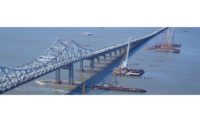As the regional construction market continues its upward swing, design firm Greenman-Pedersen Inc. is in the right place at the right time. The firm, which has offices across the country and several in New York state and New Jersey, opened an office in Manhattan this year to stay close to its New York City clients. The new location has paid off; GPI has jumped to fourth place on ENR New York’s Top Design Firm rankings. The firm posted revenue of $158.72 million in 2015, up from $144.09 million the previous year. CEO Ralph Csogi cites the megaprojects the firm took on in the past year as a catalyst for its growth.
“By far our largest project has been … the New Tappan Zee Bridge,” says Csogi of the $3.9-billion project, for which GPI is providing design and construction quality assurance services. Transportation is 90% of GPI’s portfolio, with the firm participating in many of New York City’s array of high-profile projects. The Port Authority of NY & NJ chose the firm as construction manager and inspector on the $1.2-billion George Washington Bridge capital and operating construction program, an estimated nine-year effort to fully rehabilitate the span’s suspension system and access ramps and make other mechanical and electrical modifications.
GPI also is working with the New York State Dept. of Transportation on the reconstruction of the Prospect Mountain highway in Binghamton. The project, on which the firm is providing construction management and inspection services, completed its $135-million first phase in 2015.
The designer is heavily involved in New Jersey transportation work as well. The Port Authority selected it to serve as construction manager and inspector on the Bayonne Bridge Navigational Clearance project, which will raise the bridge 65 ft to allow larger cargo vessels better access to area port facilities. Once the estimated $1-billion project is complete, the navigational clearance will reach 215 ft.
GPI is also a prime consultant for the New Jersey Turnpike Authority, designing the widening of 15 miles of the Garden State Parkway between Exit 98 and Exit 83. “This is a priority project as crashes and fatalities within this corridor are significantly higher than the statewide rate,” says Csogi. He adds that 11 of the top 30 accident priority locations that need upgrade are within the corridor, making it the parkway’s most hazardous stretch. The $250-million project includes construction of 12-ft-wide shoulders and replacement or widening of nearly 30 bridges. “The lack of shoulders and adequate clear zones has been documented in significantly reducing emergency service response time and restraining police enforcement activity,” says Csogi.
Outside of the transportation sector, GPI is involved in the engineering and design of five schools—three located in Brooklyn, one in Staten Island and one in the Bronx—that were greatly damaged by Hurricane Sandy. In addition to repairing what the storm destroyed, the firm is focusing on flood mitigation and building hardening. “These five schools were prioritized by the New York City School Construction Authority (SCA) as urgent with scoping and design phases fast-tracked for completion within seven months,” Csogi says. The $80-million project, which includes repairs to MEP systems and new architectural and structural designs, is currently under construction.
The firm’s expertise in bridge rehabilitation gained it a five-year contract from the Federal Highway Administration’s National Highway Institute to provide teachers for a number of NHI training classes pertaining to bridge and ancillary structure safety inspection, construction inspection and rehabilitation design. The firm has also taught bridge rehabilitation courses in Canada and was asked by the Panama Canal Authority in 2014 to teach a weeklong course on bridge rehabilitation design to engineers on the huge canal expansion project. While the company has taught several classes on this subject in the U.S., the Panama trip marked the first time a course was taught outside the country.
Looking at future trends, Csogi says alternative project delivery methods are increasingly being used, particularly by the Port Authority, citing the recently launched public-private-partnership arrangement at La Guardia Airport valued at $5.65 billion. He adds that technology innovations are boosting the firm’s efficiency. “3D/4D modeling being used during design and construction, notably on the Bayonne Bridge project, and the use of [mapping system] Mobile LIDAR and drones can deliver survey data quickly to streamline the design development for design-build projects,” says Csogi.
Csogi says GPI now is negotiating for two East River bridge contracts with the NYC Dept. of Transportation. The projects, a safety upgrade to the Manhattan Bridge and an upper deck replacement to the Queensboro Bridge, are expected to begin in 2017.









Post a comment to this article
Report Abusive Comment